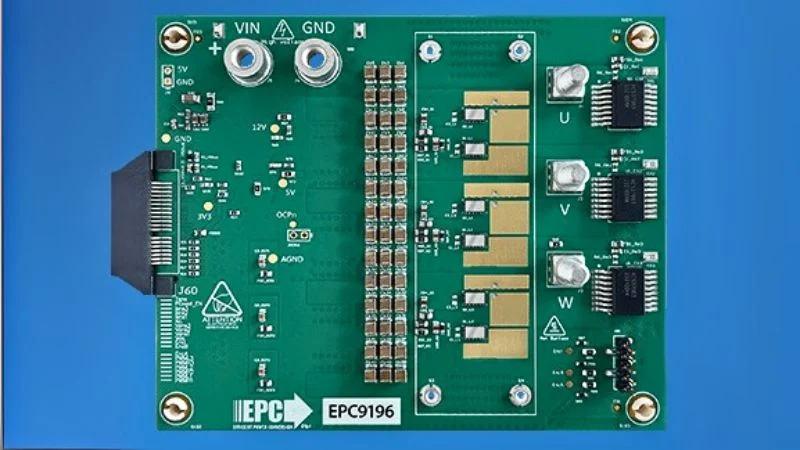EPC Intros GaN 3-Phase Motor Drive Inverter Eval Board
Efficient Power Conversion Corporation (EPC) has released the EPC9196, a 25 A, 3-phase BLDC motor drive inverter evaluation board. Designed for battery-powered applications operating between 96 V and 150 V, the board is powered by EPC’s EPC2304 eGaN FET. It is targeted at applications including robotics, autonomous guided vehicles, and compact electric vehicles.

The EPC9196 evaluation board. Image used courtesy of EPC
EPC9196 and EPC2304
Positioned to fill a performance and form-factor gap in the motor drive reference design market, the EPC9196 supports up to 35 A peak phase current and pulse-width modulation switching frequencies up to 150 kHz.
At the core of the EPC9196 inverter board is the EPC2304, a 200 V-rated enhancement-mode GaN FET featuring a maximum RDS(on) of 5 mΩ and a typical value of just 3.5 mΩ at VGS = 5 V and Id = 30 A. The FET is housed in a thermally enhanced QFN package measuring 3 mm x 5 mm and includes features such as ultra-low thermal resistance of 0.2C/W and a 0 nC zero reverse recovery charge.

The EPC2304. Image used courtesy of EPC
The inverter reference design accepts an input voltage range from 30 V to 170 V, along with integrated circuitry such as gate drivers, current and voltage sense lines, and housekeeping power to support external controllers. Current sense is provided with high bandwidth and phase resolution, while dV/dt performance is optimized for motor drive environments with a maximum slew rate under 10 V/ns. The system supports both sensorless and encoder-based control schemes.
So far, the EPC9196 board has been validated with a 3-kW servo motor operating at 150 V and 60 kHz while still demonstrating clean output waveforms and stable thermal behavior both with and without a heatsink. Additionally, EPC offers compatibility with motor drive control platforms from Microchip, ST, TI, and Renesas.
Managing dV/dt in Motor Drives
In high-performance motor drive applications, managing the rate of voltage change with respect to time (dV/dt) is necessary for maximum system reliability, minimum EMI, and protection for downstream components. Excessive dV/dt can cause voltage overshoots and unwanted coupling to low-voltage control circuits.
Gallium nitride (GaN) devices, such as the EPC2304, switch faster than traditional silicon MOSFETs due to their high electron mobility and zero reverse recovery characteristics. While these attributes contribute to high efficiency and fast response times, they also pose challenges in controlling transient voltage behavior. For example, dV/dt values above 10 V/ns can overstress insulation barriers and degrade motor bearing life through shaft voltages and circulating currents.

Example of EPC9196 in BLDC drive application. Image used courtesy of EPC
To address this, engineers often incorporate layout techniques and drive signal conditioning. The EPC9196 achieves dV/dt control below 10 V/ns by tightly integrating the gate driver and minimizing parasitic inductance through compact PCB design. Dedicated layers for power and gate loops, orthogonal routing, and Kelvin source connections further limit voltage spikes and noise. Additionally, GaN’s fast transition edge requires precise gate resistor tuning to balance speed and dV/dt moderation.
GaN Scaling for Medium-Voltage Motion Systems
With the EPC9196, EPC extends the reach of GaN-based motor drive technology into the mid-voltage segment, addressing a previously underserved design space between low-power robotics and high-current traction systems. By combining a 200 V eGaN FET with an integrated, flexible motor inverter platform, EPC delivers a viable option for engineers targeting 96 V to 150 V applications without the overhead of developing custom power stages. Its high efficiency, thermal performance, and wide controller compatibility make it particularly attractive for design teams focused on fast-paced prototyping or production validation.
Sign up to our newsletter
Receive our latest updates about our products & promotions
